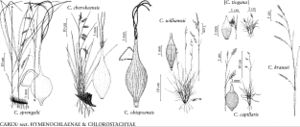Difference between revisions of "Carex capillaris"
Sp. Pl. 2: 977. 1753.
imported>Volume Importer |
GeoffLevin (talk | contribs) m (Corrected "krausei" to "krauseorum".) |
||
| (One intermediate revision by one other user not shown) | |||
| Line 36: | Line 36: | ||
|elevation=0–3500 m | |elevation=0–3500 m | ||
|distribution=Greenland;St. Pierre and Miquelon;Alta.;B.C.;Man.;N.B.;Nfld. and Labr.;N.W.T.;N.S.;Nunavut;Ont.;Que.;Sask.;Yukon;Alaska;Calif.;Colo.;Idaho;Maine;Mich.;Minn.;Mont.;Nev.;N.H.;N.Mex.;N.Y.;N.Dak.;Oreg.;S.Dak.;Utah;Wis.;Wyo.;n Eurasia. | |distribution=Greenland;St. Pierre and Miquelon;Alta.;B.C.;Man.;N.B.;Nfld. and Labr.;N.W.T.;N.S.;Nunavut;Ont.;Que.;Sask.;Yukon;Alaska;Calif.;Colo.;Idaho;Maine;Mich.;Minn.;Mont.;Nev.;N.H.;N.Mex.;N.Y.;N.Dak.;Oreg.;S.Dak.;Utah;Wis.;Wyo.;n Eurasia. | ||
| − | |discussion=<p><i>Carex capillaris</i> is somewhat variable and is often divided into two infraspecific taxa. Plants from the south are larger, have pale brown pistillate scales, and serrulate perigynium beaks. Northern plants are smaller, have medium brown pistillate scales, and smooth perigynium beaks. These characteristics are only weakly correlated, making it difficult to assign individuals to these taxa except in a very arbitrary manner. When recognized, the southern plants are called subsp. capillaris (C. chlorostachya Steven, <i>C. capillaris</i> <i></i>var.<i> major</i> Drejer ex Blytt), and the northern plants are called subsp. fuscidula (V. I. Kreczetovicz ex T. V. Egorova) Á. Löve & D. Löve.</p><!-- | + | |discussion=<p><i>Carex capillaris</i> is somewhat variable and is often divided into two infraspecific taxa. Plants from the south are larger, have pale brown pistillate scales, and serrulate perigynium beaks. Northern plants are smaller, have medium brown pistillate scales, and smooth perigynium beaks. These characteristics are only weakly correlated, making it difficult to assign individuals to these taxa except in a very arbitrary manner. When recognized, the southern plants are called subsp. <i>capillaris</i> (<i>C. chlorostachya</i> Steven, <i>C. capillaris</i> <i></i>var.<i> major</i> Drejer ex Blytt), and the northern plants are called subsp. <i>fuscidula</i> (V. I. Kreczetovicz ex T. V. Egorova) Á. Löve & D. Löve.</p><!-- |
| − | --><p>T. V. Egorova (1964) recorded the Asian species <i>Carex</i> | + | --><p>T. V. Egorova (1964) recorded the Asian species <i>Carex delicata</i> C. B. Clarke (as <i>C. karoi</i>) from Colorado; no specimens have been seen that confirm that report, and it seems likely an error because T. V. Egorova (1999) indicated the species is restricted to Asia. This species has dense lateral spikes with 15–30 perigynia, the perigynia rounded at the apex and abruptly beaked, with the beak 0.1–0.2 mm.</p><!-- |
| − | --><p><i>Carex</i> | + | --><p><i>Carex tiogana</i> D. M. Taylor & J. Mastrogiuseppe from northern California cannot be satisfactorily distinguished from <i>C. capillaris</i>, although it possesses an uncommon combination of characteristics. It is probably best treated as a variety or subspecies of <i>C. capillaris</i>. Until a more satisfactory account of the variability in <i>C. tiogana</i> and its relationship with <i>C. krauseorum</i> is produced, its status must remain uncertain.</p> |
|tables= | |tables= | ||
|references= | |references= | ||
| Line 61: | Line 61: | ||
|publication year=1753 | |publication year=1753 | ||
|special status=Illustrated | |special status=Illustrated | ||
| − | |source xml=https:// | + | |source xml=https://bitbucket.org/aafc-mbb/fna-data-curation/src/2e0870ddd59836b60bcf96646a41e87ea5a5943a/coarse_grained_fna_xml/V23/V23_873.xml |
|genus=Carex | |genus=Carex | ||
|section=Carex sect. Chlorostachyae | |section=Carex sect. Chlorostachyae | ||
Latest revision as of 13:42, 10 September 2024
Culms to 60 cm. Leaf blades flat or, sometimes, folded (in dwarf individuals), 2–9 cm × (0.75–)1–4 mm. Terminal spike usually staminate, level with or over-topped by some lateral spikes, 4–10 × 0.7–1.4 mm. Lateral spikes 2–4, 6–20-flowered, 5–20 × 3–4 mm, the proximal usually drooping, often ± erect in dwarf arctic-alpine plants. Pistillate scales pale to medium brown with hyaline margins and paler midvein, ovate, 1.8–2.8 × 1–1.5 mm, apex obtuse or acute. Staminate scales pale brown with hyaline margins and green or brown midvein, oblong, 2.5–3.2 × 1–1.2 mm, apex obtuse or acute. Perigynia veinless, except for 2 marginal veins, oblong-ovate, 2.3–3.5 × 0.8–1.2 mm; beak 0.5–1 mm, margins entire or serrulate. Achenes obovoid, 1.2–1.7 × 0.7–1 mm. 2n = 54.
Phenology: Fruiting late spring–mid summer.
Habitat: Mesic to moist tundra, seeps on cliffs, rocks, and slopes, fens, meadows, shores, prairie sloughs, edges of sphagnum mats, moist woods
Elevation: 0–3500 m
Distribution

Greenland, St. Pierre and Miquelon, Alta., B.C., Man., N.B., Nfld. and Labr., N.W.T., N.S., Nunavut, Ont., Que., Sask., Yukon, Alaska, Calif., Colo., Idaho, Maine, Mich., Minn., Mont., Nev., N.H., N.Mex., N.Y., N.Dak., Oreg., S.Dak., Utah, Wis., Wyo., n Eurasia.
Discussion
Carex capillaris is somewhat variable and is often divided into two infraspecific taxa. Plants from the south are larger, have pale brown pistillate scales, and serrulate perigynium beaks. Northern plants are smaller, have medium brown pistillate scales, and smooth perigynium beaks. These characteristics are only weakly correlated, making it difficult to assign individuals to these taxa except in a very arbitrary manner. When recognized, the southern plants are called subsp. capillaris (C. chlorostachya Steven, C. capillaris var. major Drejer ex Blytt), and the northern plants are called subsp. fuscidula (V. I. Kreczetovicz ex T. V. Egorova) Á. Löve & D. Löve.
T. V. Egorova (1964) recorded the Asian species Carex delicata C. B. Clarke (as C. karoi) from Colorado; no specimens have been seen that confirm that report, and it seems likely an error because T. V. Egorova (1999) indicated the species is restricted to Asia. This species has dense lateral spikes with 15–30 perigynia, the perigynia rounded at the apex and abruptly beaked, with the beak 0.1–0.2 mm.
Carex tiogana D. M. Taylor & J. Mastrogiuseppe from northern California cannot be satisfactorily distinguished from C. capillaris, although it possesses an uncommon combination of characteristics. It is probably best treated as a variety or subspecies of C. capillaris. Until a more satisfactory account of the variability in C. tiogana and its relationship with C. krauseorum is produced, its status must remain uncertain.
Selected References
None.
